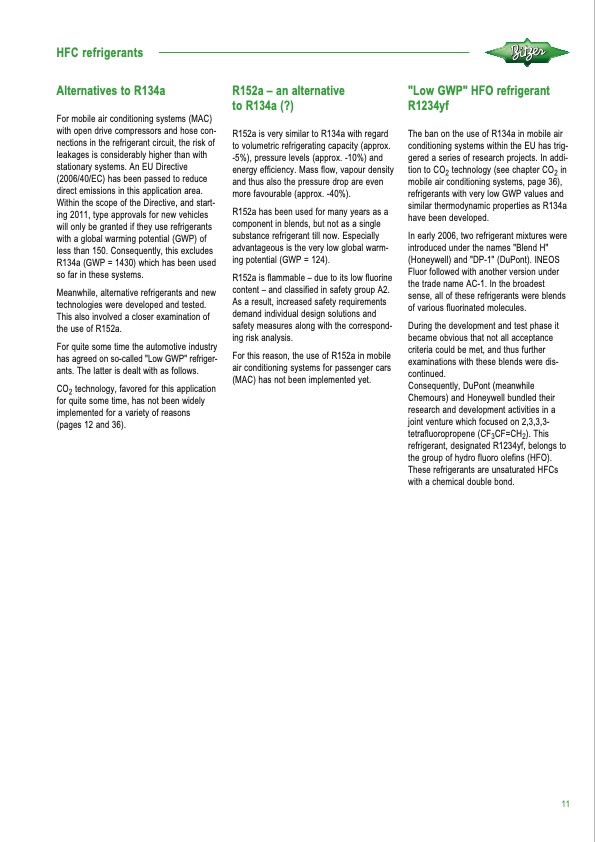
PDF Publication Title:
Text from PDF Page: 011
HFC refrigerants Alternatives to R134a For mobile air conditioning systems (MAC) with open drive compressors and hose con- nections in the refrigerant circuit, the risk of leakages is considerably higher than with stationary systems. An EU Directive (2006/40/EC) has been passed to reduce direct emissions in this application area. Within the scope of the Directive, and start- ing 2011, type approvals for new vehicles will only be granted if they use refrigerants with a global warming potential (GWP) of less than 150. Consequently, this excludes R134a (GWP = 1430) which has been used so far in these systems. Meanwhile, alternative refrigerants and new technologies were developed and tested. This also involved a closer examination of the use of R152a. For quite some time the automotive industry has agreed on so-called "Low GWP" refriger- ants. The latter is dealt with as follows. CO2 technology, favored for this application for quite some time, has not been widely implemented for a variety of reasons (pages 12 and 36). R152a – an alternative to R134a (?) R152a is very similar to R134a with regard to volumetric refrigerating capacity (approx. -5%), pressure levels (approx. -10%) and energy efficiency. Mass flow, vapour density and thus also the pressure drop are even more favourable (approx. -40%). R152a has been used for many years as a component in blends, but not as a single substance refrigerant till now. Especially advantageous is the very low global warm- ing potential (GWP = 124). R152a is flammable – due to its low fluorine content – and classified in safety group A2. As a result, increased safety requirements demand individual design solutions and safety measures along with the correspond- ing risk analysis. For this reason, the use of R152a in mobile air conditioning systems for passenger cars (MAC) has not been implemented yet. "Low GWP" HFO refrigerant R1234yf The ban on the use of R134a in mobile air conditioning systems within the EU has trig- gered a series of research projects. In addi- tion to CO2 technology (see chapter CO2 in mobile air conditioning systems, page 36), refrigerants with very low GWP values and similar thermodynamic properties as R134a have been developed. In early 2006, two refrigerant mixtures were introduced under the names "Blend H" (Honeywell) and "DP-1" (DuPont). INEOS Fluor followed with another version under the trade name AC-1. In the broadest sense, all of these refrigerants were blends of various fluorinated molecules. During the development and test phase it became obvious that not all acceptance criteria could be met, and thus further examinations with these blends were dis- continued. Consequently, DuPont (meanwhile Chemours) and Honeywell bundled their research and development activities in a joint venture which focused on 2,3,3,3- tetrafluoropropene (CF3CF=CH2). This refrigerant, designated R1234yf, belongs to the group of hydro fluoro olefins (HFO). These refrigerants are unsaturated HFCs with a chemical double bond. 11PDF Image | REFRIGERANT REPORT 21

PDF Search Title:
REFRIGERANT REPORT 21Original File Name Searched:
A-501-21_EN.pdfDIY PDF Search: Google It | Yahoo | Bing
CO2 Organic Rankine Cycle Experimenter Platform The supercritical CO2 phase change system is both a heat pump and organic rankine cycle which can be used for those purposes and as a supercritical extractor for advanced subcritical and supercritical extraction technology. Uses include producing nanoparticles, precious metal CO2 extraction, lithium battery recycling, and other applications... More Info
Heat Pumps CO2 ORC Heat Pump System Platform More Info
| CONTACT TEL: 608-238-6001 Email: greg@infinityturbine.com | RSS | AMP |